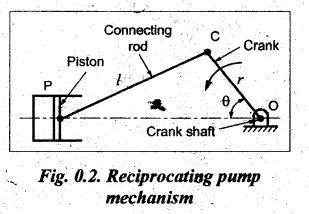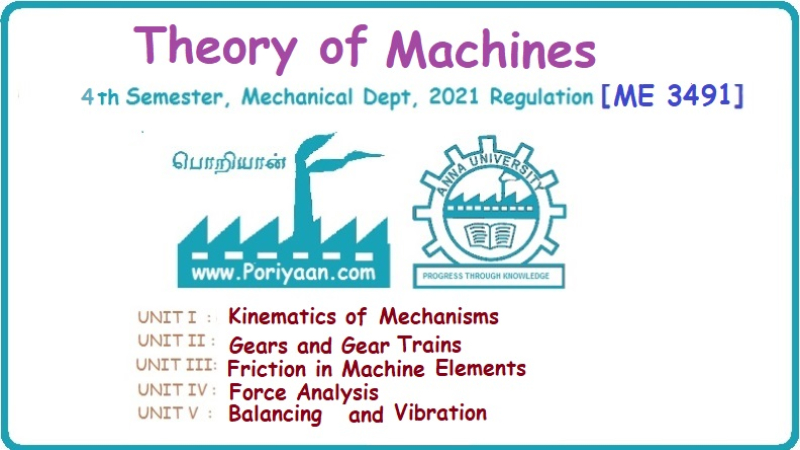Theory of Machines: Unit I: Kinematics of Mechanisms
Branches of mechanics of machines
Illustration
The 'Mechanics of Machines' subject may be divided into kinematics of machines and dynamics of machines, as shown in Fig.0.1.
BRANCHES OF MECHANICS OF MACHINES
• The 'Mechanics of
Machines' subject may be divided into kinematics of machines and dynamics of
machines, as shown in Fig.0.1.

• The definitions of above branches
are summarised in Table 0.1.
Table 0.1. Definitions of various branches of mechanics of
machines
1. Kinematics: It is a branch of
Theory of Machines which deals with the study of relative motion between the
various parts of the machines, without reference to the forces causing a body
to move. Thus the kinematics is a study of geometry of motion (ie.,
displacement, velocity, and acceleration of machine part).
2. Dynamics: It is a branch of
Theory of Machines which deals with the forces and their effects, while acting
upon the machine parts in motion.
(a) Statics: It is a branch of
Theory of Machines which deals with the forces and their effects while the
machine parts are at rest. The mass of the parts is assumed to be negligible.
(b) Kinetics: It is a branch of
Theory of Machines which deals with the inertia forces which arise from the
combined effect of the mass and motion of the machine parts.
1. Illustration

The
above divisions of the subject may be.... illustrated by considering the case
of a reciprocating pump. In the reciprocating pump (Fig.0.2), the piston
reciprocates in cylinder due to the crank shaft which receives uniform rotation
from a motor coupled to it. The pressure drop created inside the cylinder
enables water to enter in during forward stroke and to be pumped out during
return stroke. Thus the rotary motion of the crankshaft (which is the input)
gets converted to output reciprocating motion of the piston P through the crank
OC and connecting rod CP.
• Under the study of
kinematics, the relative motion of various parts can be determined with respect
to various positions of the crank. Only the lengths of a crank (r) and
connecting rod (l), the angular position of the crank (θ) and the speed
of the crank shaft are necessary to determine the kinematics (i.e.,
velocities and accelerations of the different parts) of the problem.
• Under the study of
statics, the force acting on the piston due to water and the reaction forces of
different parts can be determined. For this, different parts are considered as
pin jointed frames. Knowing the pressure and area of piston, the force acting
on the piston at various positions may be determined; then by resolution of
forces, we can also determine the various forces acting on other parts i.e.,
connecting rod, crank, etc of the pump.
• Under the study of kinetics,
the inertia forces acting on various parts of the pump (due to motion arising
out of the masses and mass moment of inertia of the moving parts) can be
determined, with the help of Newton's second law of motion.
However, the net force on every part is a combination of static and dynamic analysis. The complete study may require identifying the cross-section of some parts to withstand these loads.
Theory of Machines: Unit I: Kinematics of Mechanisms : Tag: : Illustration - Branches of mechanics of machines
Related Topics
Related Subjects
Theory of Machines
ME3491 4th semester Mechanical Dept | 2021 Regulation | 4th Semester Mechanical Dept 2021 Regulation
